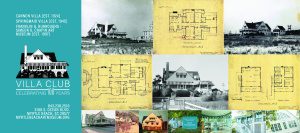Join The Villa Club
1924 – 2024
The Villa Celebrates Its 100th Anniversary

Click Here to Join THE VILLA CLUB
What a remarkable year this is for the Art Museum! It was 100 years ago that a charming beach cottage—now home to all our exhibition galleries—was built on a quiet stretch of the Atlantic coastline eight miles north of where it stands today. The fortunes and misfortunes of the 100 years that have followed its construction is a saga of survival and triumph and certainly a history worth celebrating.
The home was built in 1924 by Joseph Maner Lawton and his son Edward Maner Lawton, whose construction company, Southern Builders of Florence, SC, was one of the earliest to build cottages along this once sparsely populated stretch of beach. The home’s original owner, Eugene Thomas Cannon, a scion of the South’s once massive textile industry, vacationed at the home for a quarter century until it passed to another textile family in 1945 and was affectionately dubbed “Springmaid Villa” by its new owner, Elliot Springs. The head of Springmaid Industries, Colonel Springs and his family, along with executives of their thriving company, enjoyed the beach retreat for decades.
The home had borne witness to the rise of its closest neighbor, the Ocean Forest Hotel with its grand surroundings—a visionary project withered in scale by the onset of the Great Depression. It withstood the destructive forces of Hurricane Hazel in 1954 and then the 1974 implosion of the Ocean Forest Hotel when the ensuing rise of beachfront condominiums brought more drastic changes.
Eventually the Close Family, the Springs heirs, turned their home over to a construction company whose owner planned to tear down the Villa to make way for condominiums. Fortunately, he was charmed by the president of the Waccamaw Arts and Crafts Guild to donate the home as a gallery for the non-profit organization. Three months later the home made a 100-block dramatic move south to Springmaid Beach and rested on land leased from Myrtle Beach Farms. That move marked the end of the Villa’s six decades as a beach home and getaway for textile magnates and its tentative beginnings as the Grand Strand’s only “home for the arts.”
It took more than another decade of fund raising, planning and expanding the vision by a determined group of believers who reached out to generous government entities, foundations, businesses and individuals—all who took heroic measures to bring the dream of a community art museum into reality. This period included further testament to the Villa’s survival prowess when Hurricane Hugo struck in 1989, protected successfully by a chain-link fence from wind-driven debris.
Long story short, 13 years after its move to Springmaid Beach, Springmaid Villa opened its doors to the public as the Franklin G. Burroughs-Simeon B. Chapin Art Museum on land given by the Burroughs and Chapin Company, which had evolved from Myrtle Beach Farms. It had been transformed into a $1.7 million non-profit institution whose story grows richer with every exhibition mounted on its walls and every visitor who passes through its doors.
To celebrate these 100 momentous years, the Art Museum invites you to join The Villa Club: Celebrating Our Past | Building Our Future.
